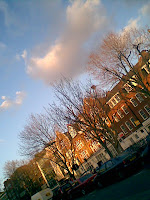Once upon a time, over a decade ago, the Jubilee Line followed the Bakerloo Line and stopped at Charring Cross. Then somebody somewhere decided to build the Millennium Dome (now the O2) out on a scrubby piece of land north of Charlton and Greenwich, and a tube line was needed to get all the tourists there. So began the Jubilee Line extension.
The Jubilee Line is an odd line. It starts way off in North London past Wembley above ground. It then dives beneath London to become one of the deepest lines. It crosses the Thames not once but four times; and of the first four stops of the extension heading out of Central London three of the four had to co-ordinate with existing stations.
Once you come above ground at Canning Town (and stay there until the end of the line at Stratford) the stations become less impressive. But the new stations (I discount London Bridge and Waterloo as they are so integral to the stations that they integrate with) are all quite 'lofty' and possibly the equivalent of modern day Cathedral Building.

1. Westminster

: this must have been one of the hardest stations to do. Running close to the historic Palace of Westminster, on the banks of the Thames and meeting up with two existing lines (Circle and District) which are sub-surface lines and not that deep. I remember as a student a journey on the way to the RICS (located on the North side of Parliament Square) and the major construction work that was evident all around. It is now a feat of engineering. The two Jubilee line platforms run at different levels between the existing SSL platforms and there is a massive network of lifts and escalators to get you where you need to go as well as some absolutely huge pieces of structure to hold the whole station up!
Ignoring Waterloo I move on to Southwark.
2. Southwark: I happened to get on a Southwark the other week. Not a very impressive station from the outside - but an award winning building according to the sign inside.

Again there is an almost Cathedral like feeling to the inside with buttresses up in the roof. There is also a small ocular as you come into the station, which is a bit of a nod back to the styles of the 1930s with the glass blocks.
Southwark doesn't have to join up with any of the other underground lines, but does have to link up with Waterloo East main line train station, which itself links with Waterloo; which is itself a station on the Jubilee Line. You could get confused if you weren't paying attention!
Ignoring London Bridge we move to Bermondsey.

3. Bermondsey: Despite my daily trips in both directions through this part of London I'd still struggle to locate Bermondsey station above ground. I didn't on my mini-trip as leaving the through the ticket gates would have added to my journey! It's a bit more light and airy here - much less of the soaring feeling, but still the unfinished concrete look of many of the stations at this end of the line.
Like many of the stations it also has the the ticket hall concourse and the middle concourse on its way down to the depths of the Jubilee Line at this point (which is still crossing at re-crossing the Thames at this point).
5. Canada Water: for residential and shopping. I've been to this one a few times when North Greenwich has been scuppered, as it is a quick bus ride on the 188 (traffic permitting).
The slightly domed roof at the entrance is a bit church like again, with the continued motif of unfinished concrete. There is some soaring architecture as you plunge down to the depths of the station the catch the trains.
The space and any natural light these station can capture is maximised by not separating the opposite running platforms (which can also be very helpful for the occasions when the Jubilee Line isn't working properly and you have to go backwards to go forwards!).


6. Canary Wharf: given its unique position amongst some of London's tallest buildings the outside of the station is always a bit in the shade. It's also a very complicated area with the underground and the DLR - but Canary Wharf underground station, like Canada Water is soaring.
It must have been another difficult one to build. Two of the four crossing of the Thames on the Jubilee Line are just to get the trains to Canary Wharf and on, digging down amongst the basins of the docks. Well it is a feat of engineering.
7. North Greenwich: we go no further as we're home. Also - after this point the line rises from under the Thames and remains above ground until Stratford.

North Greenwich is also the proud possessor of some soaring architecture. Not like many of the stations in unfinished concrete, but covered in tiny blue mosaic tiles (amazing prescience that one day O2 whose corporate colour is blue would take on the dome?!).
There are two parts to North Greenwich - the underground station and the bus terminus, itself a soaring piece of Architecture, which as far as I have ever seen (based on the crowds inside) is much larger than it needs to be, serving most of the time as a conduit to transit people between the two forms of transport available.
I am grudgingly fond of the Jubilee Line. It has its fair share of problems - Engineering works nearly every weekend, a half-hearted reliability record - but it is also South East London's quickest link to the rest of town.



